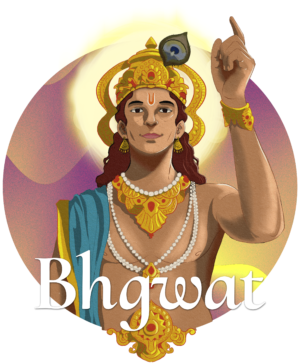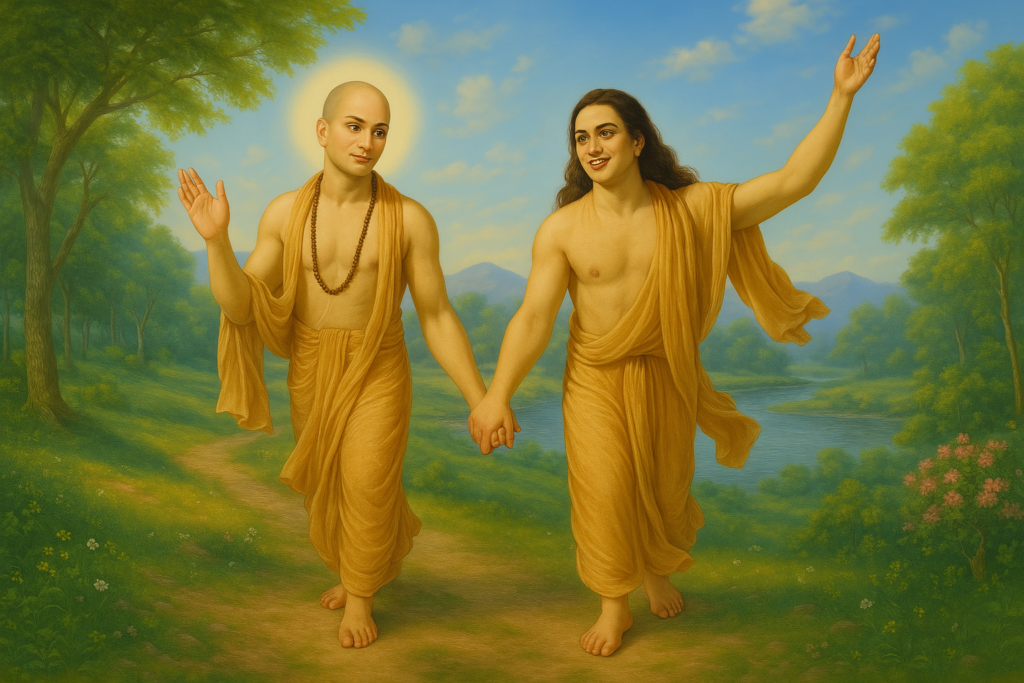The Golden Avatars: Chaitanya and Nityananda – A Divine Tale from the Scriptures
Discover the divine journey of Chaitanya Mahaprabhu and Nityananda Prabhu, the golden duo who transformed hearts through the power of love and kirtan.
In the sacred town of Nabadwip, on the banks of the Ganga, under the cool, moonlit night of Phalguna Purnima (1486 CE), the sound of conch shells echoed as a divine soul took birth. The stars danced, the trees swayed, and even the skeptical hearts of scholars in Bengal were touched with a strange joy. This child, who came to be known as Chaitanya Mahaprabhu, would grow to transform the spiritual landscape of India. But he wasn’t alone.
Some years later, another mystical soul appeared in the small village of Ekachakra—a boy named Nityananda, whose eyes sparkled with mischief and mercy. Together, they would form a spiritual duo that Vaishnavas revere as none other than Krishna and Balarama—reincarnated not to conquer kingdoms, but to conquer hearts.
1. Chaitanya in the Shastras – The Golden Krishna
While Chaitanya Mahaprabhu is not mentioned explicitly by name in the ancient Vedas, several Puranas and Tantras contain verses that Vaishnava acharyas point to as predictions of his appearance.
📜 Śrīmad Bhāgavatam (11.5.32)
“kṛṣṇa-varṇaḿ tviṣākṛṣṇaḿ sāńgopāńgāstra-pārṣadam yajñaiḥ sańkīrtana-prāyair yajanti hi su-medhasaḥ”
Translation: In the age of Kali, intelligent persons perform congregational chanting (sankirtana) to worship the incarnation of God who is always chanting the names of Krishna. Although He is Krishna Himself, His complexion is not blackish (i.e., He is golden), and He is accompanied by His associates, servitors, weapons, and confidential companions.
Vaishnava commentators, such as Srila Jiva Goswami and Srila Bhaktisiddhanta Sarasvati, interpret this as a direct reference to Chaitanya Mahaprabhu.
📜 Chaitanya Upanishad (Atharva Veda)
“sa eva gauraḥ…”
“That same Lord (Krishna) will appear in the form of Gaura (golden) in Kali Yuga, accompanied by His associates.”
From Scholar to Saint – The Journey of Chaitanya
Born as Vishvambhar Mishra, young Nimai was a genius. By age 12, he had mastered Sanskrit grammar and could outwit scholars in debate. Yet, destiny called him to a higher path.
One fateful evening, during a pilgrimage to Gaya, he met Isvara Puri, a saint in the line of Madhavacharya. When Nimai received diksha (initiation), something awakened within. His heart exploded with love for Krishna. The logician became a madman of divine love.
From then on, Nimai became Chaitanya, dedicating his life to spreading the sankirtana movement—the public chanting of the Hare Krishna maha-mantra:
Hare Krishna Hare Krishna Krishna Krishna Hare Hare
Hare Rama Hare Rama Rama Rama Hare Hare
The Mysterious Avadhut – Enter Nityananda
While Chaitanya was roaring like a lion in Bengal, another lion was awakening in the village of Ekachakra. Nityananda Prabhu, believed to be the incarnation of Lord Balarama, had left home at a young age to wander the forests, meeting saints and absorbing spiritual truths.
He finally arrived in Nabadwip, and when he met Chaitanya, it was like two halves of the same soul reconnecting. It is said, when their eyes met, both collapsed in tears—recognizing the eternal bond of Krishna and Balarama, now reborn as Gaura-Nitai.
📜 Gaura-Ganoddesha-dipika
“nityānando balarāmaḥ svayaṁ”
“Nityananda is Balarama Himself.”
A Revolution of Love – The Sankirtana Movement
Chaitanya and Nityananda traveled through villages, not to preach heavy philosophy, but to spread bhakti—the simple, sweet love for Krishna. Their method? Singing, dancing, and embracing everyone regardless of caste, class, or education.
They did not build temples or write volumes of philosophy. They gave the holy name—accessible to everyone.
“nām nām akāri bahudhā nija-sarva-shaktis…”
— Lord Chaitanya said in His Siksastakam, “The Lord has invested all His power in His names.”
The Story of Jagai and Madhai – Mercy in Action
One of the most famous stories involves Jagai and Madhai, two debauched drunkards in Nabadwip. Nityananda approached them with love and was struck on the head. But instead of retaliation, he pleaded:
“Just chant Krishna’s name once, and I’ll forgive everything.”
Eventually, they wept and fell at the Lords’ feet. Such was the transformative power of mercy that even sinners became saints.
The Final Chapter – Merging into the Infinite
Chaitanya Mahaprabhu later moved to Jagannath Puri, where he spent his final years absorbed in intense ecstasy, often crying out for Krishna like a lover pining for the beloved. His followers recorded these deep emotions in the Chaitanya Charitamrita and Chaitanya Bhagavat.
Nityananda, meanwhile, continued spreading the mission, blessing the world with his son Virabhadra Goswami, and continuing the divine lineage.
Legacy – The Foundation of the Modern Bhakti Movement
Today, the ISKCON movement, founded by A.C. Bhaktivedanta Swami Prabhupada, traces its roots directly to Chaitanya and Nityananda. The popularization of kirtan, deity worship, and the Hare Krishna mantra across the globe are fruits of this 500-year-old bhakti revolution.
In Essence – Who Were They?
- Chaitanya Mahaprabhu: Krishna Himself in a golden form, teaching love by becoming His own devotee.
- Nityananda Prabhu: The original Balarama, the divine servant and enabler of Krishna’s will, now serving as Gaura’s closest companion.
Their message was simple, yet revolutionary:
“Chant Krishna’s name, love one another, and your life will be perfect.”



